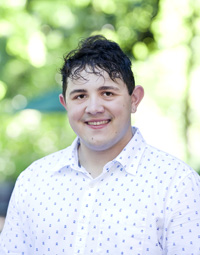-
Caitlin Carfano - Electrical Engineering, George Washington University
 LinkedIn
LinkedIn
Educational Institution: George Washington University
List of Mentors: Dr. Sharon Weiss & Tengfei Cao
Program:NSF REU
Research Project: Porous Silicon Flakes on a Flexible Substrate for Real-Time Biosensing using Smartphone Technology
Poster:
NSF REU Caitlin Carfano Poster.pdf
Research Abstract:
Biosensor research is a rapidly growing field as personal diagnostics are becoming more popular. The traditional advanced medical equipment is costly and not readily available in low resource areas. The creation of a personal diagnostic biosensor that satisfies the ASSURED (Affordable, Sensitive, Specific, User-Friendly, Rapid and Robust, Equipment-Free, and Deliverable to those in need) criteria set by the World Health Organization is ideal for people in developing countries. An optical biosensor that utilizes the smartphone camera sensor to detect color changes when an analyte is present has potential to satisfy these requirements because of the ubiquitous nature of smartphones. Porous silicon (PSi) makes an ideal candidate for an optical biosensor because it has a large internal surface area, easy manufacturing process, and high sensitivity. PSi can be electrochemically etched to form various optical structures by tuning the etching current density and time. By comparing the color of the PSi before and after analyte is introduced, the concentration of the analyte can be determined. In this work, we present a flexible biosensing device consisting of PSi on a flexible substrate (PDMS and plastic) attached to paper for sample acquisition. We demonstrate that solutions such as various glucose concentrations can be detected by both an Ocean Optics Spectrometer in a scientific lab as well as an ordinary Apple iPhone camera. As a specific potential application, this device has can be used as a wearable biosensor because of its flexible nature. In future work, the smartphone camera detection will be automated by an application (app) to display the analyte concentration detected to the user consisting of a simple user-interface.
- Co-author Journal Publication
T. Cao, C. Carfano, G. A. Rodriguez, M. H. Choudhury, F. O. Afzal, and S. M. Weiss, “Porous silicon sensors: From on-chip to mobile diagnostics,” Proc. SPIE 10891, 1089112 (2019).
- Caitlin was awarded the Rockwell Automation Scholarship from the Society of Woman Engineers in 2019.
-
Aamina Dandy - Chemical Engineering, Tuskegee University
 LinkedIn
LinkedIn
Educational Institution:Tuskegee University
List of Mentors: Dr. John Wilson & Jessalyn Baljon
Program:NSF REU
Research Project: Exploring the effects of pH-responsive polymeric nanoparticles on inflammasome activation
Poster:
NSF REU Aamina Dandy Poster.pdf
Research Abstract: The NLRP3 inflammasome is a muli-protein oligomer that forms in cells possessing the NLRP3 gene during times of distress. During its formation, the enzyme caspase-1 activates and allows for the maturation of the pro-inflammatory cytokine interleukin-1β (IL-1β). Although much is still unknown in regards to its mechanism, various studies have been done to discover the necessary stimuli for the activation of inflammasomes. The purpose of this study was to determine if pH responsive polymeric micelles are capable of activating inflammasomes. The polymers used in this study contain a hydrophilic PEG group attached to a hydrophobic group comprised of BMA and DEMAEMA. THP-1 cells were differentiated into macrophages and dosed with polymeric micelles with various compositions of BMA. HEK-Blue IL-1β reporter cells were used to monitor the secretion of IL-1β and hemolysis, QUANTI-Blue, ELISA, and CellTiter-Glo assays were used to characterize the cells. Results show that the micelles are stable at pH 7.4 and are able to escape the endosome at endosomal pH’s. In addition, significant IL-1β secretion indicates that inflammasomes are being activated. Experiments with NLRP3 gene deficient THP-1 cells show significantly reduced IL-1β secretion, suggesting that the inflammasome is the cause of IL-1β secretion. High cytotoxicity levels indicate that the polymers themselves are cytotoxic, implying that apoptosis caused by IL-1β secretion is not the sole cause of cell death. It is possible, however, that the cytotoxicity of the polymers may contribute to inflammasome activation by causing cellular distress. Future steps for this project include studying the effects of inflammasome inhibitors on the THP-1 cells to confirm inflammasome activation as the cause for IL-1β secretion. In addition, flow cytomerty can be used to verify that lysosomal rupture is the reason for inflammasome activation.
- Co-author Journal Publication
J. J. Baljon, A. Dandy, L. Wang-Bishop, M. Wehbe, M. E. Jackson and J. T. Wilson, “The efficiency of cytosolic drug Delivery using pH-responsive endosomolytic polymers does not correlate with activation of the NLRP3 inflammasome,” Biomaterials Science, 7, 1888-1897 (2019).
- Aamina was awarded a $1K travel grant at the capstone poster session.
-
Rebeca Gurrola - Physics and Mathematics, St. Mary’s University
 LinkedIn
LinkedIn
Educational Institution: St. Mary’s University
List of Mentors: Dr. Cary Pint & Janna Eaves
Program:NSF REU
Research Project: Wearable textile based energy harvester designed for human motion
Poster:
NSF REU Rebeca Gurrola Poster.pdf
Research Abstract: While there are many different methods of generating sustainable energy, small quantities of energy otherwise wasted in the pursuit of everyday activities are often overlooked. Recently, electrochemical energy harvesters joined the ranks of piezoelectric and triboelectric harvesters to convert mechanical energy into electrical energy. Here, we exploit the diversity of materials with mechanochemical response to seamlessly integrate motion harvesting into textiles for wearable applications. This study presents a novel class of safe and non-toxic “smart” energy harvesters which can be activated via sweat, stimulated here by a solution of NaCl. The resulting textile-based energy harvester comprised of a sodium tin alloy on copper fabric is intended to exploit ambient motion at frequencies of .1 Hz. In bend tests, the harvester generates a peak power of ~36.4 μW/cm2 and energy of ~131.1μJ/cm2 with each bend. Additionally, the harvester is sensitive to changes in salt concentration, suggesting applications in hydration-monitoring. These results emphasize the exciting possibilities for a new class of wearable harvesters.
- Conference Presentations
-R. M. Gurrola, J. Eaves, and C. L. Pint “Wearable textile based energy harvester designed for human motion” 2018 American Physical Society (APS) Bridge Program and National Mentoring Community Conference, Stanford, CA, November, 2018. *won 1
st
place
-R. M. Gurrola, J. Eaves, and C. L. Pint “Wearable textile based energy harvester designed for human motion” 2019 American Physical Society March Meeting, Boston, MA, March, 2019. *won outstanding oral presentation
-R. M. Gurrola, J. Eaves, and C. L. Pint “Wearable textile based energy harvester designed for human motion” Spring Research Symposium, St. Mary’s University, April, 2019. *won 3rd place oral presentation
- Rebeca was awarded Best use of Graphics at the capstone poster session.
-
Rebeca received the Presidential Award at St. Mary's University in 2019.
- Rebeca was awarded a NSF Graduate Research Fellowship in 2020.
-
Nafisa Ibrahim - Chemistry, College of St. Scholastica
 LinkedIn
LinkedIn
Educational Institution:College of St. Scholastica
List of Mentors: Dr. Kelsey Hatzell & Fengyu Shen & Marm Dixit
Program:NSF REU
Research Project:Co-extruded Composite Polymer Electrolytes for Solid-State Batteries
Poster:
NSF REU Nafisa Ibrahim Poster.pdf
Research Abstract: Composite polymer electrolytes are exciting alternatives for all solid-state batteries due to their advantages of scalability and overall better mechanical response. This work is evaluating strategies for scalable manufacturing of functionally graded composite polymer electrolytes. A custom-built setup has been made that allows fabrication of co-extruded multimaterial composite polymer electrolytes (CPEs). The project involves performing detailed material and electrochemical characterization of these co-extruded CPE films. The study evaluates two material systems: 75 wt.% LLZO-PEO (Li7La3Zr4O12 - Polyethylene Oxide) electrolyte and 25 wt.% LLZO-PEO electrolyte. The configurations include single material films and co-extruded films of both materials with features ranging from 1 mm to 23mm. Ionic conductivity measurements were carried out to evaluate initial control parameters.
- Conference Presentations
-N.A. Ibrahim, M. Macdonald, M.B. Dixit, F. Shen, and K.B. Hatzell, "Co-extruded Composite Polymer Electrolytes for Solid-State Batteries," Ronald E. McNair Scholars Program and Research Opportunity Program, Albuquerque, NM, October, 2018.
-N.A. Ibrahim, M. Macdonald, M.B. Dixit, F. Shen, and K.B. Hatzell, "Co-extruded Composite Polymer Electrolytes for Solid-State Batteries," Research Experiences for Undergraduate Symposium, Council on Undergraduate Research, Alexandria, VA, October 2018.
- Nafisa was awarded a $1K travel grant at the capstone poster session.
- Nafisa was awarded a NSF Graduate Research Fellowship
-
Joshua Livingston - Chemical Engineering, Prairie View A&M University
 LinkedIn
LinkedIn
Educational Institution: Prairie View A&M University
List of Mentors: Dr. Kane Jennings & Ricky Deng
Program:NSF REU
Research Project: pH-Responsive Copolymer Films
Poster:
NSF REU Joshua Livingston Poster.pdf
Research Abstract: pH-Responsive films are polymer films that react to changes in pH by accepting or donating protons, which changes the properties of the film. In this report, we have prepared pH-responsive ester and carboxylic acid copolymer films by SiROMP (Surface-initiated Ring Opening Metathesis Polymerization), coupled with a quick copolymer preparation step. We successfully prepared poly(norbornene diacyl chloride) (pNBDAC) films by vapor phase SiROMP. Due to the high reactivity of acyl chloride groups, we can easily modify the pNBDAC films with other functional groups. In the copolymer preparation step, pNBDAC films are immersed into an ethanol and water mixture to form the carboxylic acid and ester copolymer. The ratio of the ethanol-water mixture determines the composition of the copolymer film the reaction yields. Electrochemical Impedance Spectroscopy was used to characterize the film impedance at different pH values. The pH-responsive behavior of the copolymer film depends on its carboxylic acid and ester content.
- Co-author Journal Publication
X. Deng, J. Livingston, N.J.Spear, and G.K. Jennings "pH-Responsive Copolymer Films Prepared by Surface-Initiated Polymerization and Simple Modification", Langmuir, 36, 715−722 (2020).
- Livingston was awarded Fan Favorite at the capstone poster session.
-
Caylee Marshall - Chemical Engineering, University of Kentucky
 LinkedIn
LinkedIn
Educational Institution:University of Kentucky
List of Mentors: Dr. Craig Duvall & Prarthana Patil
Program:NSF REU
Research Project:In-vitro material characterization of ROS-responsive poly(thioketal) polymeric scaffolds for treatment of chronic wounds
Poster:
NSF REU Caylee Marshall Poster.pdf
Research Abstract: Chronic wounds affect millions of Americans each year. There are currently limited and inefficient treatment regiments which augment wound healing. The use of degradable biomaterials, such as foams, is being extensively studied for the treatment of chronic wounds. These wounds are characterized by poor vasculature and elevated levels of reactive oxygen species (ROS). Our motivation is to leverage elevated ROS levels as a stimuli for the degradation of poly(thioketal) urethane (PTK-UR) scaffolds. We have previously fabricated urethane foams using two component liquid reactive molding by using trifunctional isocyanates and mercaptoethylether (MEE)PTK diol1. Nonspecific degradation of polyester urethane foams can be eliminated by using ROS degradable PTKUR chemistry to augment formation of granulation tissue and decrease fibrosis. This project has focused on making increasingly hydrophilic polymeric PTK diol components to decrease immunogenicity and increase clearance of scaffold degradation products.
-
Rebecca Mendez - Electrical Engineering, Northeastern University
 LinkedIn
LinkedIn
Educational Institution:Northeastern University
List of Mentors: Dr. Ronald Schrimpf & Andrew Tonigan
Program:NSF REU
Research Project:Heavy Ion Strikes on Diodes: Effects of Surface Recombination on Charge Collection
Poster:
NSF REU Rebecca Mendez Poster.pdf
Research Abstract: In the near-Earth regions of space, radiation from solar energetic events and the Van Allen Belts are a primary concern for space observation and exploration electronics. Radiation has the ability to flip digital logic states or destroy devices completely. As semiconductor device sizes approach the nanoscale, where material layers are at times only several atoms thick, radiation becomes a very significant concern for its effects on device and system performance. In this project, we investigate heavy ion and alpha particle strikes on insulated Silicon and Germanium diodes. In particular, we investigate how interfacial defects along the Si/SiO2 interface affect the charge collection process. Through finite element analysis simulations in Synopsis TCAD, we perform a parametric analysis of how changes in the length to width ratio, doping profile, and surface recombination velocity affect the current vs. time transient in a Si diode. Simulation results showed that long and thin diodes (width of .1um and length >1um), the Surface Recombination Velocity affected the Current vs. Time transients of the device. As SRV increased, the current collected decreased. In future work, we will look at Monte Carlo simulations of alpha particle strikes on diodes which will inform a probabilistic model to be compared with experimental results of alpha particle strikes on Ge diodes.
- Rebecca was name a La Communidad Latina en Accion (LaCLA) Scholar in 2019.
-
Angelo Miskalis - Biomedical Engineering, Duquesne University
 LinkedIn
LinkedIn
Educational Institution:Duquesne University
List of Mentors: Dr. Craig Duvall & Bryan Dollinger
Program:NSF REU
Research Project:Assessment of Antioxidant Copolymers for Superoxide Scavenging
Poster:
NSF REU Angelo Miskalis Poster.pdf
Research Abstract: Post Tramautic Osteoartiritis (PTOA), a form of osteoarthritis caused by the physical injury of a joint, remains one of the leading causes for mobility related diseases. PTOA is a multi-factorial disease, resulting in the inflammation and degeneration of cartilage as well as surrounding tissues within the joint. Current pharmacological treatments, such as NSAIDS, are only symptomatic. Therefore, a treatment that directly addresses the cause of PTOA is needed. Reactive oxygen species (ROS) remain a promising target for therapeutics as the overproduction of ROS, particularly superoxide anions, have been directly linked to cellular damage. TEMPO, a potential antioxidant, provides superoxide scavenging, but possesses poor retention time within joints due to insolubility and synovial clearing. To improve the bioactivity of TEMPO, random copolymers consisting of hydrophilic dimethylacrylamide (DMA) and TEMPO were synthesized as previously described. Polymer libraries consisting of various ratios of DMA:TEMPO were then formed to assess the optimum combination of ROS scavenging potential and hydrophilicity. Cellular uptake, in vitro scavenging, and in vivo scavenging assays were utilized to confirm the efficacy of each polymer. While all polymers possessed scavenging capabilities, the more hydrophilic polymers provided maximum scavenging capabilities as well as maximum cellular uptake. Results here will be utilized with continued in vivo and in vitro experiments to further confirm optimum polymer conditions for future PTOA therapies.
- Co-author Journal Publication
C.R. DeJulius, B.R. Dollinger, T.E. Kavanaugh, E. Dailing, F. Yu, S. Gulati, A. Miskalis, C. Zhang, J. Uddin, S. Dikalov, C.L. Duvall. "Optimizing an antioxidant TEMPO copolymer for ROS scavenging and anti-inflammatory effects in vivo". Bioconjugate Chemistry, 32 (5), 928-941 (2021).
- Conference Presentations
-A. J. Miskalis, B. R. Dollinger, C. DeJulius and C. L. Duvall “Assessment of Antioxidant Copolymers for improved ROS Scavenging in Post-Traumatic Osteoarthritis” Society for Biomaterials National Conference, Seattle, WA, April, 2019.
-A. J. Miskalis, B. R. Dollinger, C. DeJulius and C. L. Duvall “Assessment of Antioxidant Copolymers for improved ROS Scavenging in Post-Traumatic Osteoarthritis” AiChE Regenerative Engineering Conference, Pittsburgh, PA, October, 2018.
- Angelo was awarded a $1K travel grant at the capstone poster session.
-
Oluwalade Ogungbesan - Chemical Engineering, University of Maryland, Baltimore County
 LinkedIn
LinkedIn
Educational Institution:University of Maryland, Baltimore County
List of Mentors: Dr. Clare McCabe & Alex Yang
Program:NSF REU
Research Project:Using molecular simulation to understand the interactions between DNA-coated graphene sheets and phospholipid bilayers
Poster:
NSF REU Oluwalade Ogungbesan Poster.pdf
Research Abstract: Graphene has been beneficial in the area of gene and drug delivery because of its unique structural properties. Derived from its parent material, graphite, graphene is a nanocarbon composed of two-dimensional hexagonally arranged carbon atoms, which causes it to have a porous structure and contain only hydrophobic regions. Particularly, certain chemicals like DNA can be transported into lipid bilayers with the use of graphene due to the molecules both containing nonpolar regions, but more studies are needed in order to gather information on how graphene affects lipid bilayers.1 Some ways to determine these effects include controlling the graphene’s angle of insertion and force applied to pull the graphene sheet into the bilayer. These experiments are modeled by using molecular dynamic simulations, which provides a cost effective and fast way of simulating these experiments. Based on our experiments, the maximum work and force done on the graphene increased when the force constant and the angle increased, and DNA remained on the graphene sheet when using a force constant no greater than 250kJ/mol x nm2. 1. Bao, H. et al. Chitosan-functionalized graphene oxide as a nanocarrier for drug and gene delivery. Small 7, 1569–1578 (2011).
- Journal Publication
-T.C. Moore, A. Yang, O Ogungbesan, R. Hartkamp, Q. Zhang and C. McCabe, “Influence of a Coating on the Interaction Between Graphene Nanoflakes and Lipid Bilayers” Journal of Physical Chemistry B, 120 (37), 9944-9958 (2019).
- Conference Presentations
-O. Ogungbesan, Alexander Yang, and Clare McCabe, "Using Molecular Simulation to Understand the Interactions Between DNA-Coated Graphene Sheets and Phospholipid Bilayers," Council on Undergraduate Research's Research Experience for Undergraduates Symposium, Alexandria, VA, October, 2018.
- Olu was named a Meyerhoff Scholar
-
Keiann Simon - Forensics, Queensborough Community College
 LinkedIn
LinkedIn
Educational Institution:Queensborough Community College
List of Mentors: Dr. Kane Jennings & Josh Passantino
Program:NSF REU
Research Project:Photosystem I Proteins in Gel-State Biohybrid Solar Cells
Poster:
NSF REU Keiann Simon Poster.pdf
Research Abstract: In converting solar energy into chemical energy, photosynthesis is necessary for the sustainability of all life on Earth. This use of light energy triggers a chain of electron transfers, which when interfaced with photoactive protein complexes and conducting materials for photovoltaics, can be utilized via light induced photocurrents. The Photosystem I (PSI) super-complex demonstrates the desired properties of photochemical applications for the enhancement of green renewable energy. PSI has unique structures such as P700 and the FB site, that can accept electrons from a wide range of donors and has a reducing potential near -0.6V vs. SHE (Standard Hydrogen Electrode) respectively. A process that benefits from this phenomenon is the production of PSI-derived biohybrid solar cells. Existing research focuses on integrating PSI in liquid-based electrochemical cells; however, liquid cells tend to suffer from poor portability and solvent loss due to evaporation requiring frequent replacement. Consequently, a gel-base medium, namely agarose, was substituted to address these issues. The benefits included not only that these gel-state devices would be more portable and durable than the liquid mediums, but they would also be organic, inexpensive, and easy to process. Another advantage is that liquid-state devices require three electrodes whilst the gel-sate devices only require two. Four mediators (ferri/ferrocyanide, sodium ascorbate-DCPIP, methyl viologen, and potassium chloride) and four cathodes (copper, aluminum, gold, and p-doped silicon) were examined. This research will incorporate photo-chronoamperometric tests to find best conductive gel for the devices, thus determining which configuration is superlative for optimization into this new field of green renewable energy.
- Co-author Journal Publication
J. Passantino, K. Wolfe, K. Simon, D.E. Cliffel, and G.K. Jennings “Photosystem I Enhances the Efficiency of a Natural, Gel-Based Dye-Sensitized Solar Cell”, ACS Applied BioMaterials 3, 7, 4465-4473 (2020)
- Conference Presentation
K. Simon, J. Passantino, and G.K. Jennings “Photosystem I Proteins in Gel-State Biohybrid Solar Cells” Conference Presentation 27th Annual CSTEP Statewide Conference, Bolton Landing, NY, April, 2019. (Honorable Mention)
-
Jade Stanley - Chemistry, Tuskegee University
 LinkedIn
LinkedIn
Educational Institution:Tuskegee University
List of Mentors:Dr. David Cliffel & Christopher Stachurski & Dilek Dervishogullari
Program:NSF REU
Research Project:The Modification of Photosystem I with Carbon Nanotubes for Photocurrent Generation
Poster:
NSF REU Jade Stanley Poster.pdf
Research Abstract: Photosynthesis is the biological process by which plants use visible light to produce chemical energy. Photosystem I (PSI) is one of the two main protein complexes involved in photosynthesis. The process of light absorption excites an electron and shuttles it from the P700 site to the iron cluster, FB. Due to this spatial and energetic transition of this electron, PSI is a prime candidate for implementation in photoeletrochemical cells. Biohybrid solid state and liquid solar cell devices were utilized to generate current from the light absorbed by the protein. Carbon nanotubes (CNTs) are flexible and inexpensive allotropes of carbon that have been used as conductive additives in solar cells. The objective of the experiment was to conjugate PSI proteins to carbon nanotubes and construct a solar-state device that enhances the photocurrent generated from PSI. The use of carbon nanotubes was expected to increase the surface area available for the PSI deposition, which in turn enhances photocurrent production. Devices were prepared using lightly p-doped silicon as a substrate and were tested using photochronoamperometry to measure the produced photocurrent. Devices with PSI conjugated onto carbon nanotubes demonstrated an increase in photocurrent. However, due to inconsistences in the deposition methods, there was a large range in device performance; many devices produced measurably lower currents than others. Future directions will be geared towards improving device fabrication methods or further optimization of the conjugation process.
- Conference Presentations
-J. Stanley, D. Dervishogullari, C. Stachurski, K. Wolfe, G.K. Jennings, and D.E. Cliffel “The Modification of Photosystem I with Carbon Nanotubes for Photocurrent Generation” The Southern Regional Meeting of the American Chemical Society, Augusta, GA, October 2018.
-J. Stanley, D. Dervishogullari, C. Stachurski, K. Wolfe, G.K. Jennings, and D.E. Cliffel “The Modification of Photosystem I with Carbon Nanotubes for Photocurrent Generation” National Association of African American Honors Program Conference, Concord, NC, November 2018.
-J. Stanley, D. Dervishogullari, C. Stachurski, K. Wolfe, G.K. Jennings, and D.E. Cliffel “The Modification of Photosystem I with Carbon Nanotubes for Photocurrent Generation” Emerging Researchers National Conference, Washington, DC, March, 2019.
-J. Stanley, D. Dervishogullari, C. Stachurski, K. Wolfe, G.K. Jennings, and D.E. Cliffel “The Modification of Photosystem I with Carbon Nanotubes for Photocurrent Generation” Joint LSAMP/S-STEM Conference, Tuskegee, AL, April, 2019.
- Jade was awarded Best Layout at the capstone poster session.
-
Joseph Veglak - Chemical Engineering, Rose-Hulman Institute of Technology
 Educational Institution:Rose-Hulman Institute of Technology
Educational Institution:Rose-Hulman Institute of Technology
List of Mentors: Dr. Janet Macdonald & Jordan Rhodes
Program:NSF REU
Research Project:Nickel Sulfide Nanocrystal Synthesis Using Substituted Thiophenols
Poster:
NSF REU Joseph Veglak Poster.pdf
Research Abstract: Different phases and morphologies can largely effect the catalytic abilities of nickel sulfide nanocrystals. While nickel sulfides contain an abundance of different phases, phase control of these crystals can be difficult. One proposed method of selectively isolating these phases involves manipulating the sulfur reagent used, where the electron donating ability of substituent groups influences the reactivity of the sulfur precursor. Para-substituted thiophenols were used as the sulfur for this work. We have observed a phase change in this reaction: as the electron donating abilities of the substituted group increases, the oxidation number of nickel decreases, creating a different phase whose preliminary results suggest slightly different catalytic abilities. Nickel Sulfides have shown potential as catalysts, and in the future, we look to further test and enhance the particles catalytic abilities and test to see if the ligands on the particles are surface or crystal bound.
- Conference Presentation
J. Veglak, J. Rhodes, and J. Macdonald “Nickel sulfide nanocrystal synthesis using substituted thiophenols,” ACS Annual Conference, Orlando, FL, April, 2019.
- Joe was awarded a $1K travel grant at the capstone poster session.
 LinkedIn
LinkedIn
 LinkedIn
LinkedIn
 LinkedIn
LinkedIn
 LinkedIn
LinkedIn
 LinkedIn
LinkedIn
 LinkedIn
LinkedIn
 LinkedIn
LinkedIn
 LinkedIn
LinkedIn
 LinkedIn
LinkedIn LinkedIn
LinkedIn
 LinkedIn
LinkedIn
 Educational Institution:Rose-Hulman Institute of Technology
Educational Institution:Rose-Hulman Institute of Technology